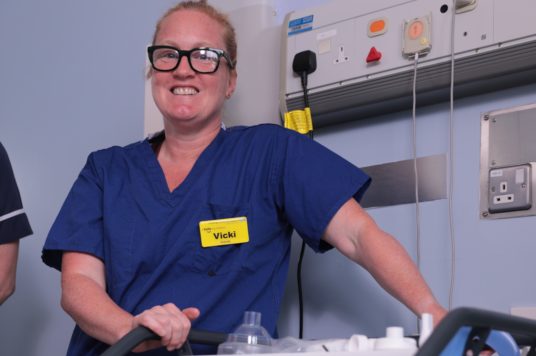Another UK first for St George’s Hospital’s latest sustainability efforts: the ‘catalytic converter for gas and air’
Dental patients and women in labour will be given ‘green gas and air’ at St George’s hospital, reducing pain on the planet as well as during childbirth and tooth extractions.
In a UK first, St George’s University Hospital is investing in a device in its dental unit dubbed the ‘catalytic converter of gas and air’.
Nitrous oxide, regularly combined with oxygen, to produce Entonox, provides sedation in dental and emergency procedures as well as pain relief in labour. The gas has almost 300 times the global warming potential of carbon dioxide.
The mobile nitrous oxide conversion unit at St George’s will be the first in the UK to be trialed in a dental department and breaks gas down into harmless oxygen and nitrogen before it is released, thereby reducing its impact on the environment as well as staff exposure to the medical gas.
It is already being used in St George’s endoscopy and the midwifery led birth unit.
Dr Emma Evans, South West London Clinical Lead for Net Zero and Consultant Anesthetist at St George’s, said:
“Patients won’t experience any difference in their clinical care and how they receive pain relief remains the same, but after its use, it will be disposed of through the device to breakdown the gas to be more environmentally friendly.
“After trialing mobile devices in the dental, endoscopy and midwifery led birth units, we will scope out the potential for a central system to service a larger number of clinical areas too, to further reduce our overall carbon footprint.”
This is the second time St George’s has been recognised for its sustainability strategy after the Trust was the first in the UK to decarbonise its patient menu last year.
Kate Slemeck, Managing Director for St George’s University Hospitals NHS Foundation Trust, said:
“These devices eliminate 99% of the nitrous oxide that is released into the environment and their implementation plays a small but very important part in our overall green plan, paving the way for us to reduce our emissions.
“We all have a role to play in tackling climate change and St George’s is committed to playing its part in making the NHS the world’s first net zero health service.”
With more sustainable investments and interventions like these, we will reduce the rise in patients coming in with conditions exacerbated by air pollution such as asthma, cardiovascular disease (CVD), and lung cancer.
The introduction of these devices, which are made by Medclair, working in partnership with Ultraflow manufacturer BPR Medical, is the latest effort by St George’s to reduce its carbon footprint.
Managing Director of BPR Medical, Richard Radford, said:
“We are delighted to be working to provide a sustainable and environmentally-friendly pain relief solution for patients at St George’s. The device handles exhaled nitrous oxide in a way that is both climate-friendly and convenient to the patient, while giving them safe and efficient pain relief.”
Chief Executive of Medclair, Jonas Lundh, said:
“It’s fantastic to see that more hospitals across the NHS are adopting nitrous oxide conversion systems. Scaled across the entire health service, this technology could reduce NHS nitrous oxide emissions by up to 75%.
“We are seeing more and more innovative efforts like this across the health service to tackle the global climate crisis.”
Other sustainability initiatives at St George’s include:
- Using recycled surgical instruments and items in operating theatres. For instance, in hand surgery, an estimated 22,000 items per year have been saved from the surgical kits used in operations
- A combined heat and power plant on the St George’s site provides excess renewable energy back to the National Grid – 1.9million kWh was exported back in 2019-20, enough to boil a kettle over 46 million times
- St George’s became the first Trust in the country to introduce a carbon-neutral patient menu, sourced from ingredients with a low carbon footprint. Around 23 tonnes of carbon is saved, the equivalent of planting 30 acres of forests.
Notes to editors
About St George’s, Epsom and St Helier University Hospitals and Health Group
St George’s University Hospitals NHS Foundation Trust is the largest healthcare provider and major teaching hospital for south west London, Surrey and beyond – and one of the largest healthcare providers in the UK – serving a population of 3.5 million.
Its main site, St George’s Hospital – one of the country’s principal teaching hospitals – is shared with St George’s, University of London, which trains medical students and carries out advanced medical research.
St George’s is one of 11 adult and children major trauma centres in the UK, one of eight hyper acute stroke units and one of the biggest and busiest of the eight heart attack centres in London.
It is also an accredited centre of excellence for trauma, neurology, cardiology, cancer and blood pressure services and is the national centre for family HIV care and bone marrow transplantation for non-cancer diseases.
St George’s children’s services are rated outstanding by the CQC.
Other green initiative at St George’s:
- Decarbonising the patient menu
- St George’s wins grant to deliver Dora system for Cancer patients
- St George’s feature at COP26
- St George’s theatres teams introduce re-usable caps
About BPR Medical
Since 1990, BPR Medical has been an international leader in the design and manufacture of medical gas therapy solutions. The company has a reputation for innovation, quality, integrity and value is built on successfully providing market-leading products to the NHS and other healthcare providers in the UK and abroad.
In 2012, BPR Medical was honoured with the Queen’s Award for Innovation for its Firesafe™ product range.
About Medclair
By developing climate-smart products and solutions, our vision is to provide environment-friendly, cost-effective and user-friendly solutions for pain relief with nitrous oxide, thereby facilitating increased usage of nitrous oxide in the healthcare sector in an environmentally sustainable manner.
Our state-of-the-art technology has resulted in conversion systems that can be centrally installed to facilitate many treatment rooms or installed on a mobile unit. Both the larger central unit, and the mobile unit purify above 99 per cent of the nitrous oxide entering the unit. This facilitates a healthy work environment for healthcare professionals and a minimal impact on the external environment.


